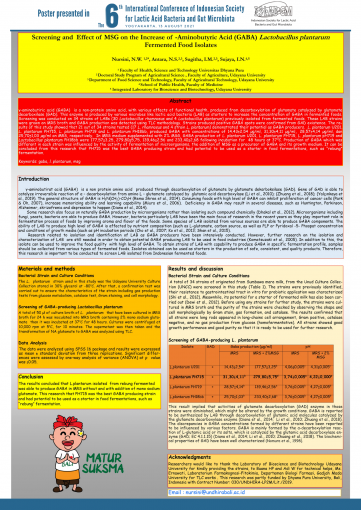
By: Nursini, N.W., Antara, N.S., Sugitha, I.M., Sujaya, I.N.
Abstract
γ-aminobutiric acid (GABA) is a non-protein amino acid, with various effects of functional health, produced from decarboxylation of glutamate catalyzed by glutamate decarboxilase (GAD). This enzyme is produced by various microbes like lactic acid bacteria (LAB) as starters to increase the concentration of GABA in fermented foods. Screening was conducted on 34 strains of LABs (30 Lactobacillus rhamnosus and 4 Lactobacillus plantarum) previously isolated from fermented foods. These LAB strains were grown on MRS broth and GABA production was detected using TLC methodology. Strains produced positive GABA spots were confirmed from GAD existence. The results of this study showed that 21 out of 34 strains tested (17 L. rhamnosus and 4 strain L. plantarum) demonstrated their potential as GABA producers. L. plantarum U201, L. plantarum PH715, L. plantarum PH719 and L. plantarum PH18bb, produced GABA with concentrations of 14,43±2,54 µg/ml, 31,30±4,11 µg/ml, 28,57±4,14 µg/ml, dan 25,70±1,03 µg/ml on MRS, respectively. In MRS medium supplemented with 2% MSG, GABA production of L. plantarum U201, L. plantarum PH715, L. plantarum pH719 and Lactobacillus plantarum PH18bb were 177,57±3,25, 279,80±5,75, 139,46±2,56 and 233,40±2,68 following incubation for 48 hours at 370C. Production of GABA which was different in each strain was influenced by the activity of fermentation of microorganisms, the addition of MSG as a precursor of GABA and its growth medium. It can be concluded from this research that PH715 was the best GABA producing strain and had potential to be used as a starter in food fermentations, such as “rebung” fermentation.
Keywords: gaba, l. plantarum, msg
*This poster was presented in The 6th International Conference of Indonesian Society for Lactic Acid Bacteria and Gut Microbiota (6th ISLAB) on 13th August 2021
More information about the poster -> Click here
More information about the event -> Click here
